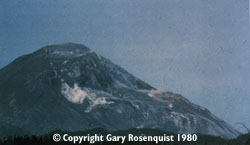Wave Propagation
There are several geologic events that can trigger the propagation of a tsunami
- Earthquakes: generally tectonic rebound at or near a subduction zone, when there is a vertical component to crustal movement that displaces a large volume of the overlying water
- Landslides: often earthquake or volcanically triggered, can be purely submarine or the slide could begin on land and slide into the water (i.e. a collapsing volcano)
- Volcanic activity: usually subaerial, could be pyroclastic flows, lahars, nuees ardants, or collapse of the mountain side
- Impact of a large meteor or asteroid

Tsunami generating earthquakes most often occur at subduction zones. The tsunami is propagated when the toe of the overriding plate (red star) rebounds, displacing a large volume of water.
http://www.globalsecurity.org/eye/images/tsunami-2.jpg

A simple Newtonian model that relates the height of a slide, the angle of the slope, and the coefficient of friction to the run out distance of the slide.
Courtesy of Dr. Jim Beget, UAF

A simple model of submarine slide tsunami propagation
Courtesy of Dr. Jim Beget, UAF

May 18, 1980 collapse of the north flank of Mt St Helens
http://volcanoes.usgs.gov/Hazards/What/Landslides/MSHSlide.html

Toutle River Valley filled with the debris avalanche from the collapse of Mt St Helen's north flank. The valley was filled for 22km at a depth of 45m. Had this avalanche slide into the ocean, a tsunami may have been generated.
http://volcanoes.usgs.gov/Hazards/What/Landslides/MSHSlide.html

Pyroclastic flows are hot masses of gas and rock that can travel at speeds up to 200km/hr. Volumes can reach a magnitude of cubic kilometers. As one could imagine, this combination of volume and velocity could generate a very destructive, but usually localized, tsunami.
http://hvo.wr.usgs.gov/volcanowatch/2003/03_06_26.html

The impact of a bolide (large meteor or asteroid) could have many devastating effects on the Earth, one of which could be a massive global tsunami. Many have hypothesized that such impact, associated tsunamis and atmospheric turmoil could have brought about the mass extinction that killed the dinosaurs at the end of the Cretaceous about 65Ma.